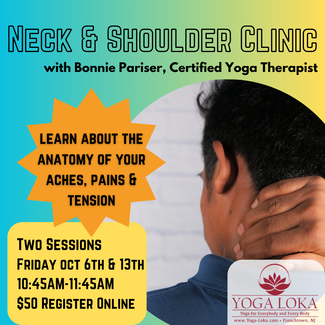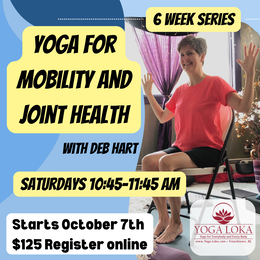|
There are a lot of things in our bodies that happen on their own. Our food is digested, our blood is cleaned, our heart beats. Our blood is oxygenated, wastes are eliminated. Here's one thing that does not naturally occur in our bodies, especially as we age: range of motion does not increase. In fact, range of motion decreases on its own as we age, all by itself! It's not only programmed into the aging process, but technology is also helping facilitate this loss as well. Backup cameras in our cars mean we don't have to turn our neck to get out of a parking spot, so we don't. Your cute little baby pinky fingers that used to be necessary to hit 'A' and ';' while typing now just hang out doing nothing as we use our phones with either speech recognition, swipe, or type with our thumbs. Remote and voice controls now mean we can do everything from turning on the TV and lights to starting our washer, dryer, and dishwashers without ever standing up. You can check the contents of your refrigerator with an app and order what is missing from another app and perhaps even have it delivered without having to walk from your parked car to the store.
I consider it a blessing to have broken my wrist on my dominant side. Now that I am out of a cast, daily tasks are basically therapy. I turn a doorknob, chop an onion, pick up heavy things all with my right hand. That is the hand that instinctively wants to do all the stuff because it is my dominant hand. I doubt I would have gotten back as much range of motion so quickly if the injury occurred on my left side, which would, post-cast, just basically hang out watching while my right side does all the work. One of the reasons we do so many complicated transitions in vinyasa flow classes and experiment with new ways of entering or exiting a pose is so we move in ways we don't usually move. Flowing along will hopefully reveal a range of motion that is limited in your body. If we don't uncover these places that are limited, we, of course, cannot address them. Our decreased range of motion in one place might start to grow and spread out. Fascia starts to stiffen, muscles start to atrophy, and then the fascia and muscles next door think, 'that's a great idea; I'll take a vacation too.' We also start to compensate, straining other functions. The next thing we know, a healed broken wrist might result in limited range of motion in our fingers and elbows, and perhaps even shoulders and hips. As part of my morning meditation I do a complicated set of little-known mudras. I was pleased that I was able to do most of them with my cast on, but two of them were understandably quite difficult. I figured that would ease up once the cast was off, but lo and behold, the mudras are now more difficult! The restriction mostly has to do with the way my right middle finger reaches for my left little finger, and my ring finger has to stay up. It's definitely a bizarre move and not one that is replicated in the movements of my life, other than this mudra. The restriction of these fingers led me to realize that I can barely lift it compared to how high I can lift my left ring finger with all the other fingers staying still and flat on a table. Now maybe that seems unimportant on first glance, but consider how that immobility can spread. By the time it comes for me to actually be able to take piano lessons, a lifelong dream, will that stiffness have spread to my other fingers? Most likely, I have already started to compensate for this lack of strength and movement in my right ring finger, but now that it has been revealed to me through this fancy mudra, I'm on it! Finger exercises are now part of my routine. The point is we may not recognize how a range of motion is naturally decreasing if we don't stay in the game of moving and being willing to move in strange new ways and examine how we are compensating. This is being beautifully revealed in our Joint Freeing Series immersion that began a few weeks ago. People are finding out what their bodies can't do, especially one side compared to the other. As a yoga therapist and teacher, seeing people uncover these weaknesses is far more gratifying than seeing people who can easily perform complicated moves or 'advanced' asanas. For those of you who might be curious how your body is not moving, give the JFS a try. It is like a microscope, when done correctly and with awareness, that shows you so many wonderful and interesting things. When you find the things you cannot do, it is time to celebrate! You are on your way to unraveling something big.
0 Comments
Today, I accomplished my first significant athletic endeavor since I broke my wrist – I went on a bike ride! I wore my brace since it was considered a "high-risk" activity. It felt incredible to be on the move again. I did notice that I couldn't shift with my right hand, but the hills weren't too challenging, so I managed quite well.
This phase of recovery reminds me of the first trimester of pregnancy. It's a period characterized by no outward signs of difficulty (no visible baby bump or arm cast), yet the internal struggles are very real. Just as the first trimester can be the most demanding for some, I've found this stage of healing to be more painful than any other phase of my injury. The reason is straightforward – I'm doing more now, which is fantastic (yay!), but it also means experiencing more discomfort (boo). What's intriguing about this recovery process is how it aligns with my five years of research and experimentation with fascia. Here's a partial checklist of my observations:
|
AuthorAmarjyothi Archives
July 2024
Categories
All
|



 RSS Feed
RSS Feed
